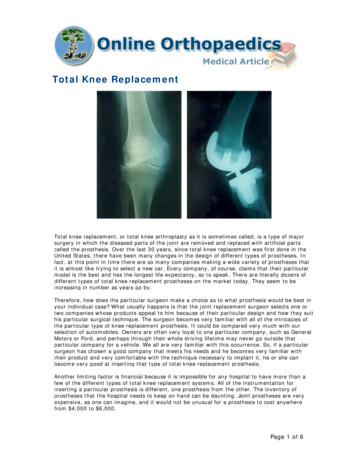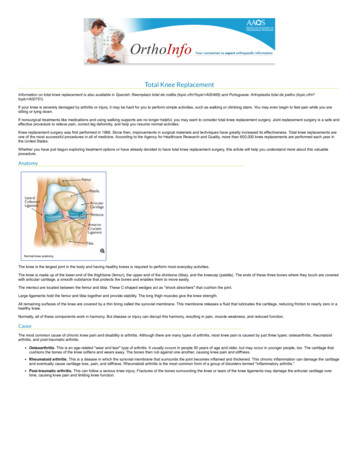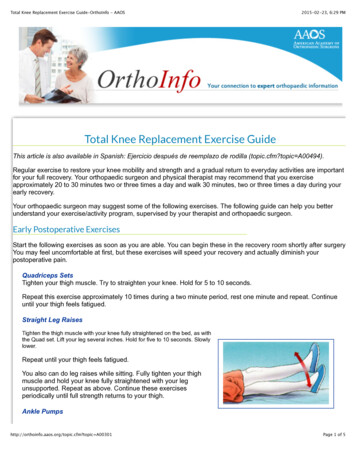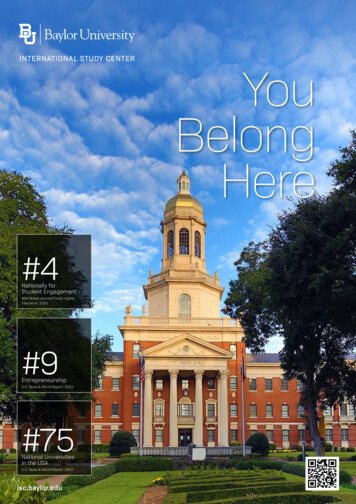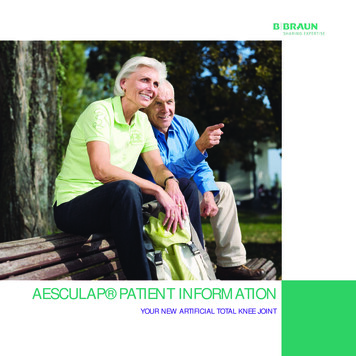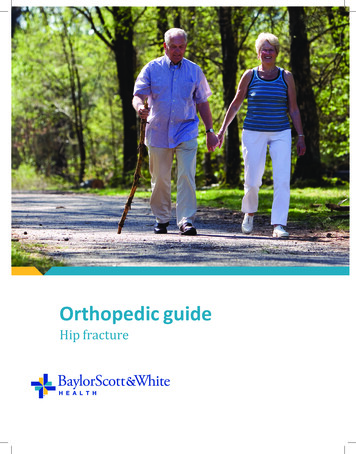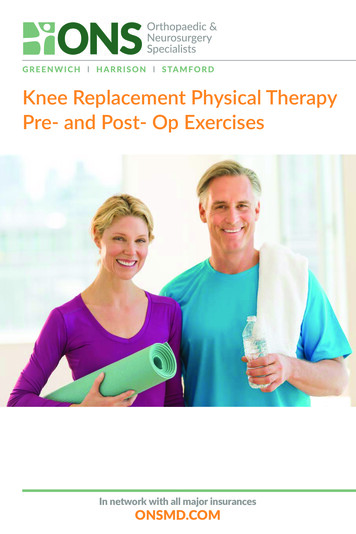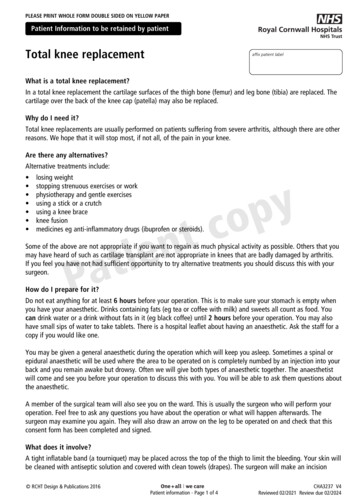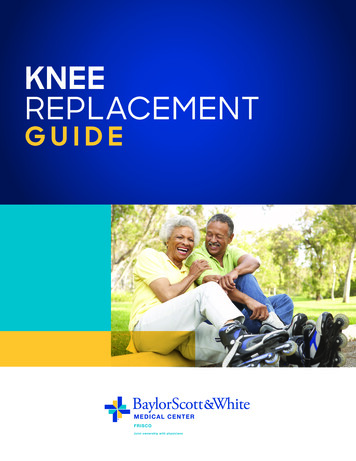
Transcription
KNEEREPLACEMENTGUIDE
KNEE REPLACEMENT GUIDE Baylor Scott & White Medical Center – FriscoContentsINTRODUCTION1Mission statement and vision14 Recognizing and preventing complications2Accommodations near the hospital14 Deep vein thrombosis2Pre-certification and registration information14 Pulmonary embolism2Registration15 Infection3Contact phone numbers and policies15 PneumoniaINFORMATION ABOUTKNEE REPLACEMENTPHYSICAL THERAPY4General facts21 The cane5Our goal22 The shower benchPREPARING FOR SURGERY16 The walker23 Helpful hints23 Safe vehicle transfers5Preparing for surgery – a timeline6The night before and the day of surgeryKNEE EXERCISE REHABILITATION6Directions for use of 2% chlorhexidine24 Ankle pumpsgluconate cloth24 Calf stretching7After surgery – home care25 Hamstring stretching7Preoperative checklist25 Quad sets Home safety checklist25 Straight leg raises What to bring to the hospital26 Arc quadsYOUR HOSPITAL STAY8Day of admission9Post-surgery, day one26 Heel slides26 Larrick’s exercise26 Gravity-assisted knee flexion11Your discharge from the hospitalKNEE PRECAUTIONS FOR HOSPITALAND HOME11More about patient rehabilitation criteria27 Precautions and guidelines10 Post-surgery, day twoAT HOMEFREQUENTLY ASKED QUESTIONS12 Shower29 General questions12 Care of your incision12 Anticoagulation medication13 Pain medication
1KNEE REPLACEMENT GUIDE Baylor Scott & White Medical Center – FriscoWelcome,MissionWe believe that healthcare should be about you and your family. We striveThe mission of Baylorto deliver healthcare compassionately and to act with absolute integrity.Our team of professionals will work closely with you and your family toprovide an ideal patient experience. We want to help you heal quickly andget back to the life you enjoy.We want to put your mind at ease by including you as an active participantin your care. Our goal is to involve you in every aspect of your care. We willrely on you to give us accurate information regarding your medical history,home medications and pain level and to voice any concerns you may haveduring your stay. It is important to remember that you play a significant rolein your recovery.Scott & White – Friscois to provide theopportunity to everyindividual within Friscoand the surroundingcommunities, thehighest standard ofhealthcare services,designed withexcellence, deliveredwith dignity andOur goal is to make you feel comfortable and secure throughout thissafety foremost, andprocess. Please ask any questions or share any concerns with the staff sodemonstrated withthat we can make this experience the best for you. We are committed torespect to those weyou, our patient, and want you to receive quality care during your visit withserve.us. Thank you for allowing us to care for you. It is our privilege to be yourhealthcare provider.VisionThe information in this guide will help you prepare for surgery and toBaylor Scott & Whiterecover following surgery. Please read through this material several times.Identify any topics you want to discuss with your physician or with thehospital staff. Write down any questions you have, and be sure to ask yournurse and physician. We are here to help you through this experience andto meet your individual needs.– Frisco, through thecombined effortsof our board ofmanagers, physiciansand our staff, desiresSincerely,to provide health careTrevor Castanedaa new standard forChief Executive OfficerBaylor Scott & White Medical Center – Friscothat is recognized asexcellence and patientsatisfaction.
2WHERE TO STAYKNEE REPLACEMENT GUIDE Baylor Scott & White Medical Center – FriscoACCOMMODATIONSNEAR BAYLOR SCOTT& WHITE – FRISCOPre-certification andauthorizationComfort SuitesMany insurance companies require pre-4796 Memorial DriveThe Colony, TX 75056972.668.5555 (direct)1.800.4CHOICE (reservations)choicehotels.comcertification or pre-authorization forsurgery. Please contact your insurancecompany or notify them of yourupcoming surgery. They will then contactyour physician for clinical information.Embassy Suites7600 John Q. Hammons DriveFrisco, TX 75034972.712.7200 (direct)embassysuites.comFairfield Inn by Marriottmanaged care plans require approvalfor surgery before a surgical date canbe selected.You may log on to BSWHealth.com/4712 W. Plano ParkwayPlano, TX 75093972.519.0303 (direct)1.800.228.2800 (reservations)fairfieldinn.comFrisco for a current list of contracts withHampton Inn & SuitesRegistration:pre-op class3199 Parkwood Blvd.Frisco, TX 75034972.712.8400 (direct)1.866.751.8400 (reservations)REGISTRATIONWorkman’s compensation and someHoliday Inn3400 Parkwood Blvd.Frisco, TX 75034972.668.5959 (direct)1.888.465.4329 (reservations)holidayinn.comMicrotel Inn & Suites (Plano)19373 Preston RoadDallas, TX 75252972.248.7045 (direct)1.888.771.7171 (reservations)microtelinn.cominsurance plans along with contact phonenumbers for individual departmentsthroughout the hospital.Register for Total Joint PreoperativeEducation class by calling our schedulingdepartment at 214.407.5054.Registration: surgeryYou may register for your surgery onlineat BSWHealth.com/Frisco. Our patientregistration form is listed under “Patientsand Visitors”.Your surgeon may request that youschedule pre-admission testing beforeWestin Stonebriar Resortyour surgery. Please call 214.407.5066 to1549 Legacy DriveFrisco, TX 75034972.668.8000 (direct)1.888.627.8441 (reservations)westin.com/stonebriarmake an appointment.
KNEE REPLACEMENT GUIDE Baylor Scott & White Medical Center – FriscoContact phone numbersRegistration214.407.5066Pre-Admission Nurse214.407.5166Social Services214.407.5437Patient Advocate214.407.5180Director – Center of Excellence Total Joints214.407.5128Total Joint Manager Post-Surgical Unit214.407.5250Chief Nursing Officer214.407.5190Associate Admin. Clinical Services214.407.5050Complaints/complimentsWe appreciate your comments. The employees at Baylor Scott & White – Friscobelieve your feedback allows us the opportunity to grow.COMPLAINTSAt Baylor Scott & White – Frisco, we pride ourselves on the customer service weprovide for our patients and their families. If, at any time, you are not satisfied withthe care you receive, room environment, etc., please let us know immediately.You may file a complaint by contacting any of the following personnel:Post-Surgical Unit Managerext. 5250Patient Advocateext. 5437Directer, Center of Excellenceext. 5128Total Joint Nursesext. 5168, 5169Chief Nursing Officerext. 5190COMPLIMENTSOur nurses and hospital staff strive to make your stay a pleasant experience. If youfeel someone has gone above and beyond to care for you or your family member,please take the time to fill out a Pursuit of Excellence card. Pursuit of Excellencecards are located in the front lobby outside the cafeteria, the nurses stations, ormay be obtained by asking one of our staff members. Pursuit of Excellence cardsare read by senior administration, the department director, department managerand the employee.COMPLAINTS/COMPLIMENTS
4KNEE REPLACEMENT GUIDE Baylor Scott & White Medical Center – FriscoInformation about knee replacementThe following information contains general guideline, which may need to bemodified to address your specific needs. To that end, we would like to encourageABOUT KNEEREPLACEMENTyou to learn as much as possible about your responsibilities as a knee replacementpatient. We realize surgery is stressful, but, rest assured, we are dedicated totaking outstanding care of you. We truly view your surgical experience and care asa team responsibility.GENERAL FACTSArthritis, congenital or development problems, or trauma can work againstthe natural function of your joint causing pain in the knee and leg and severelyrestricting your range of motion. These problems may force you to walk with a limpor restrict your everyday activities.The medical term for knee replacement is arthroplasty, and it is a proven methodof treatment for individuals suffering from arthritis or any disabling knee problem.Arthroplasty can provide relief from pain and discomfort, straighten the leg, workto correct deformities in the leg and enhance joint stability.During the past two decades, the science of knee replacement has madegreat strides, resulting in several types of prostheses available for use. Using acombination of metal and plastic, your physician will create a new joint for you.Currently, there are two methods used for attaching your new joint, or prosthesis,to the bone and providing a stable fixation.Cemented: Poly methyl methacrylate is used to attach the prosthesis to bone like aglue or grouting material.Cementless: The bone ingrows directly to the prosthesis. The majority of kneereplacements are cemented.Your general health, weight, age, bone structure and activity level are some ofthe factors your physician will use to determine the type of prosthesis that will beright for your surgery. A knee replacement consists of removing the arthritic ordamaged surface of the femur and tibia and replacing the surfaces with a metalprosthesis. Then a plastic bearing is placed between the surfaces. The deepportion of the kneecap that would articulate against the metal is replaced by aplastic cap.This booklet is intended to be a guide for our patients having a single kneereplacement. Revision knee replacement follows a similar course, but dependingon the type of revision preferred, your postoperative course may be modified. Still,other patients may require revision surgery because of a failed knee implant.
KNEE REPLACEMENT GUIDE Baylor Scott & White Medical Center – FriscoOUR GOAL5Our goal is to see you through your knee replacement surgery with fewcomplications and the greatest result – both in your recovery, and in the relief andcomfort knee replacement can provide. That’s why we continue to strive to provideyou with the best environment for surgery and recovery. And, why we look to you tobe conscientious in adhering to the program your physician develops for you.Preparing for surgery – a timelineONE MONTH PRIOR TO SURGERY1.Purchase immunonutrition recovery drink. Your surgeon’s office will give youinstructions regarding this drink.2. If you require a letter of medical necessity for a leave of absence for youremployer, or for the durable medical equipment, please submit your request inwriting to your physician’s office at this time.TWO WEEKS PRIOR TO SURGERYTwo or three weeks before your surgery, you will have a medical evaluationperformed by an internist. This evaluation may include lab tests, a chest X-ray andan electrocardiogram. The results of these tests will allow us to decide if you areready for surgery.Once cleared for surgery, the hospitalist will see you every daywhile you are in the hospital and will monitor your program medically. They will beresponsible for ordering your diet and medications and will handle any medicalproblems that might arise.TEN DAYS PRIOR TO SURGERYYour surgeon will give you specific instructions about your home medications. As ageneral rule, you must discontinue use of any aspirin, aspirin-containing products,ibuprofen or certain anti-inflammatory drugs 10 days before surgery. In addition,please stop fish oil, ginkgo biloba and ginseng. Most arthritis medications shouldalso be discontinued. These products tend to increase bleeding during and aftersurgery. You may take Tylenol as a substitute. Discuss any other medications youare taking, such as those for heart, diabetes or high blood pressure, with theinternist clearing you for surgery.FIVE DAYS PRIOR TO SURGERYDrink one immunonutrition recovery drink two times per day for five days.PREPARINGFOR SURGERY
6KNEE REPLACEMENT GUIDE Baylor Scott & White Medical Center – FriscoThe night before and the day of surgeryDO NOT EAT OR DRINK ANYTHING AFTER MIDNIGHT EXCEPT A CARBOHYDRATEDRINK THREE HOURS BEFORE SURGERY.PREPARINGFOR SURGERYYour surgeon’s office will give you instructions regarding this drink.TO DECREASE THE BACTERIAL COUNT ON YOUR SKIN, we recommend cleaningthe skin with a solution, such as 2% chlorhexidine gluconate cloth. Your physicianIf you or yourhas requested that we give or send this product to you for use prior to surgeryfor killing and stopping the growth of germs on your skin. There are a total of sixfamily havecloths. (Three packets with two cloths to each packet). Please do not put lotionany questionson your body.about gettingready forsurgery,medications,diet orany otherproblems,Directions for use of2% chlorhexidine gluconate cloth(If your doctor has given you other instructions, follow those instead of this list.)THE NIGHT BEFORE SURGERY1.Please shower using a freshly laundered washcloth and towels. Use one clothpleaseto moderately scrub the part of your body where the surgery is planned.contact yourScrub for about three minutes. Use another two cloths to apply the productphysician’sto the rest of your body. Leave a minimum of one hour between shower andapplication of chlorhexidine gluconate cloths. If you open a pack and only useoffice.one cloth, leave the other cloth in the packet to use in the morning.2. When the product dries (it might be tacky or slightly sticky), put on cleansleepwear and, if possible, sleep on clean bed linens. The goal is to have theproduct remain on your skin so that it will start to kill germs.THE MORNING OF SURGERY AT HOME1.Do not shampoo your hair, shower or bathe because we want to keep theproduct you applied the night before on your skin.2. Using the remaining cloths, apply the product in the same manner as the nightbefore.AT THE HOSPITALThe hospital staff may give you more cloths and ask you to repeat this process whenyou arrive in the preoperative area. If you do not have the exact amount of product,don’t worry; concentrate on the area of skin that will be involved in the surgery. If youhave any questions, please call the infection preventionist at 214.407.5434.You should not use this product if you are allergic to chlorhexidine gluconate. Keepout of eyes, ears, mouth, mucous membranes and vaginal/perineal area.
KNEE REPLACEMENT GUIDE Baylor Scott & White Medical Center – FriscoAfter surgery - home care7While in the hospital, a social worker will meet with you to arrange home care aftersurgery. All equipment needed after surgery will be arranged before you leave thehospital. A physical therapist will discuss several issues with you. such as the widthof your doorways, the height of the chair you should sit in, unsafe rugs on the floor,PREPARINGFOR SURGERYthe best location for your bed, and any other areas as needed.You can also select a home care company based on past preferences orrecommendations. If you have a preference, please let the hospital dischargeIf you alreadyplanner know the name of the agency, the telephone number and any contactown a walker,name you may have at least two weeks prior to your surgery date. If you do notour physicalhave a preference, we will offer you several options based on your location andtherapistinsurance stipulations.will need toexamine itPre operative checklistsprior to use.HOME SAFETY CHECKLISTo Remove rugs or uneven surfaceso Make clear pathways for your walkero Check height of mattresso Count your stairso Place common items close byo Plan easy meals in advanceo Evaluate the need for temporaryo Place nonskid bath mat in your tub/pet relocationshowerPACKING LISTMedical items:o CPAP or BIPAP machine (if applicable)o Home medications in their original bottles EXCLUDING: Anxiety or sleep medications: Lorazepam, Alprazolam, Ambien Pain medications: Oxycodone, Hydrocodone, Morphine, Tramadol, Lyrica Supplements or over-the-counter medicationsPaperwork:o Copy of Advanced Health Directive (if applicable)o Driver’s license or photo IDo Insurance cardPersonal items:o Loose-fitting clothes (e.g. nightshirt, shorts, sweats, etc.)o Underwear, socks, nonskid slippers or tennis shoeso Personal toiletrieso Eyeglasses, contact lenses with case/solution, hearing aid and batterieso Phone charger (extra long)Any electrical items must be preapproved by Plant Operations.Do not bring:o Valuables, including jewelryPlease bringit to thehospital, butleave it in thecar, labeledwith yourname.A familymember orfriend canbring thewalker toyou after youhave beenadmitted tothe inpatientorthopedicunit.
8KNEE REPLACEMENT GUIDE Baylor Scott & White Medical Center – FriscoYour hospital stayDAY OF ADMISSIONYOURHOSPITAL STAYTypically, your surgeon’s office will ask you to arrive two hours prior to yourscheduled surgery time. Enter through the main lobby doors and go to theregistration desk at the main entrance. The person at registration will verify orobtain your admission information, and your person will be given a pager. At theappropriate time, your pager will sound and a nurse will take you to your room inpre-op. You will then be asked to complete any remaining paperwork, your vitalsigns will be checked and you will meet the anesthesiologist.Your anesthesiologist will discuss the anesthesia options available to you anddetermine the best anesthesia technique for your unique medical history. An IV willbe started and the anesthesiologist may give you some medication to help you relax.One support person may wait with you until it is time for your surgery. Once youare taken to the operating room, your pre-op nurse will instruct your supportperson where to wait based on your surgeon’s preference. When your surgery iscompleted, your surgeon or his representative will meet with your support person.Once your surgery is complete, you will be taken to the recovery room forapproximately one to two hours. No visitors are allowed in the recovery area. Yourfamily will be notified when you are discharged from the recovery area and sent toyour hospital room.WHAT TO EXPECT AFTER YOUR KNEE REPLACEMENT SURGERYYou will be taken to the inpatient orthopedic unit from the recovery room. Allpatient rooms are private. Your nurse will be monitoring your vital signs (pulse,temperature and respiration rates) frequently, and an automatic blood pressurecuff will check your blood pressure. You may be placed on a monitor to watch yourheartbeat and oxygen levels.Pain control: Tell your nurse if your pain is not controlled. You may be given yourpain medication by IV or orally.Other medications: You will receive several doses of intravenous antibiotics toprevent infection.Diet: With your physician’s approval, you may start taking clear liquids. You will begiven a menu and instructions to order your meal tray through Dine on Demand.Bathroom activities: A Foley catheter may be inserted into your bladder duringsurgery to keep your bladder drained of urine at all times. This will be removed atthe discretion of your surgeon.
KNEE REPLACEMENT GUIDE Baylor Scott & White Medical Center – FriscoBreathing exercises: A nurse will remind you to deep breathe every 2 hours9while you are awake. An incentive spirometer will be provided by the respiratorytherapist to assist you in your breathing exercises. This will help keep your lungsexpanded and help prevent pneumonia.Special equipment: An IV line, usually placed on the back of your hand, wrist orforearm, will provide the fluids and medications your body needs during and afteryour surgery. A Hemovac tube may be used to drain excess fluid away from yoursurgical wound.Personal care: The nursing staff or patient care technician will assist you with yourpersonal hygiene.POST-SURGERY – DAY ONEYour pulse, temperature and respirations will be checked by your nurse or patientcare technician on a regular basis.Pain control: As your numbing medicine begins to wear off, tell your nurse whenyou begin to feel discomfort, as it takes about 30 minutes for your pain medicationto start working. You must ask for your pain medication.Diet: If you are able to tolerate liquids without nausea, you will gradually advance toa solid, general diet.Bathroom activities: You will be able to call for assistance to use the bedside orrestroom commode.Breathing exercises: You will be reminded to deep breathe with your incentivespirometer every two hours.Special equipment: Your IV may continue through this day. If you have a Hemovactube, it may stay in, or be removed depending on how much is drained.Personal care: The nursing staff or patient care technician will assist you with yourpersonal care.Activity and movement: You will see a representative from physical therapy twicetoday. They will provide you with an instruction sheet for exercises. With theassistance of the physical therapy staff, you may dangle your legs from the bed,stand with a walker, and use the walker to move around your room. The goal is tohave you up and walking. Do not get out of bed without assistance from the staff.Discharge plans: Your social worker may visit with you today to discuss dischargeneeds, which may include discharge disposition (home healthcare, rehabilitationunit or skilled nursing unit) and discharge equipment (walker). Depending on yourprogress, you will most likely be discharged today (POD-1).YOURHOSPITAL STAY
10KNEE REPLACEMENT GUIDE Baylor Scott & White Medical Center – FriscoPOST-SURGERY – DAY TWOIf extended hospitalization is needed for medical reasons, your pulse, temperatureand respirations will continue to be checked by your nurse.YOURHOSPITAL STAYBathroom activities: You will be able to call for assistance to use the restroom orbedside commode as needed.Pain control: Please tell your nurse if you are not getting pain relief.Breathing exercises: You will be reminded to deep breathe with your incentivespirometer every two hours.Personal care: The nursing staff or patient care technician will assist you with yourpersonal care.Activity and movement: You will see a representative from physical therapy twicetoday for morning and afternoon physical therapy sessions. Flexion of the knee to90 degrees is important.Discharge plans: Your social worker will continue to monitor your needs asthey apply to your discharge plans. Most other patients are discharged today,depending on their progress and previous medical history. If you are beingdischarged, your walking goal is 200-plus feet. You will receive final physicaltherapy discharge instructions on car transfers, stairs and home physical therapy.If you are going to rehab, your orders for therapy will be sent to your new therapist.The name and contact number for home health will be written on the bottom ofyour discharge paperwork given to you by your nurse at discharge. Please note: Ahome health aide is not a part of home care.Your family: You may have one visitor at any time and your family can assist youwith your exercises.
KNEE REPLACEMENT GUIDE Baylor Scott & White Medical Center – FriscoYour discharge from the hospital11It is unlikely a patient will need more intensive physical therapy or more skillednursing than can be provided in the home setting. Should your circumstancesrequire more, we will refer you to a rehabilitation or skilled nursing facility andwill discuss these requirements with you further during your stay in the hospital.Medicare or your insurance rules may determine what is available to you. In the lastseveral years, Medicare has applied very specific and strict rules to which patientsmust adhere to qualify for rehabilitation. It is no longer guaranteed. In either case,your timely recovery is of the utmost importance.INPATIENT REHABILITATION CRITERIAThe Centers for Medicare and Medicaid Services (CMS) states 60 percent of allpatients admitted to inpatient rehabilitation facilities must meet at least one of thefollowing criteria:CMS top rehabilitation diagnoses Stroke Brain injury Deformity at birth Amputation Fracture of hip Spinal cord injury Major multiple trauma, for example motor vehicle accident Neurological disorders, for example multiple sclerosis, Parkinson’s disease ormuscular dystrophy Burns Active rheumatoid arthritis Knee or hip replacement-Patient had both knees replaced at the same time, or both hips replaced atthe same time-Patient is extremely obese with body mass index (BMI) of at least 50 at thetime of admission-Patient is age 85 or older at the time of admissionAdditional admission criteria Ability to tolerate three hours of therapy or be able to progress to three hourswithin seven days Must require 24-hour nursing, supervision and physician careNote: Living alone, or not having someone to care for you after surgery is not criteriafor admission to a rehabilitation facility.YOURHOSPITAL STAY
12KNEE REPLACEMENT GUIDE Baylor Scott & White Medical Center – FriscoAt homeThe anticipation is over. You have spent weeks waiting for the hospital, the surgeryand the ability to walk with your new knee joint. Now it’s time to readjust. It will takeAT HOMEyour new knee six to eight weeks to heal, and you must learn to balance exerciseperiods with rest periods. It is very important to not overdo or push yourselfbeyond the limits of pain. It is also very important to take your pain medication,especially if pain is preventing you from doing your exercises.Do nottake anymedicationYou may need to call your physician’s office for a follow-up appointmentapproximately two to four weeks after your surgery.otherSHOWERthan whatIt is safest to shower sitting down. If you have an Aquacel dressing, you may get ithas beenwet. If you have a gauze dressing, you need to keep it covered during your shower.prescribedYou will receive further dressing instructions upon discharge.withoutcheckingwith yoursurgeon’soffice first.CARE OF YOUR INCISIONIf you have staples that hold the incision together, they will remain in place for 10to 14 days. To keep the wound clean, just let water run over it and pat it dry. It is notnecessary to scrub the incision and no special soap is required. You may showeras long as there is no drainage from the wound and you have been taught how totransfer safely.If you have staples, your physician or home care nurse or therapist will remove thestaples in 10 to 14 days from the date of your surgery.ANTICOAGULATION MEDICATIONAnticoagulation medication slows the process of blood clotting and may beprescribed to you when you are discharged from the hospital to reduce to risk ofblood clots. The length of this prescription will vary depending on each patient’sindividual needs.Anticoagulant medications are of critical importance if you have a historyof a blood clot or clots, or if you were on an anticoagulant before your kneereplacement surgery. If your physician or the physician’s team decides you need aprescription anticoagulant, your nurse will visit with you before you are dischargedto tell you all about the medication and answer any questions you or your familymay have.
KNEE REPLACEMENT GUIDE Baylor Scott & White Medical Center – FriscoPain medication13This is one of the most important sections in this booklet. Knee replacement canresult in considerable pain and discomfort for a period of time after surgery. It isour intention to provide you with as much relief from this pain as possible. Oncehome from the hospital, many of our patients find they only require Tylenol for mildpain control. A few patients may require a narcotic medication to alleviate pain.However, your physician will work with you to determine the best pain medicationfor you. You may also receive an anti-inflammatory medication. You should notreceive pain medication from any other source.During surgery, a numbing medicine that blocks nerve impulses in your body isinjected into the tissue around your hip joint and will usually last 24 to 48 hours.All narcotic-based pain medications can cause constipation. Most people havea bowel movement two to three days after surgery. If you have not had a bowelmovement, taking Milk of Magnesia and a Dulcolax suppository may be necessary.Narcotic pain medications must be used in a safe and appropriate mannerbecause of the potential for abuse resulting in drug dependency when used forextended periods of time. Dependency can happen to anyone. Your physician willclosely monitor narcotic prescriptions coming from his or her office. If this appliesto you, please help us by complying with the physician’s office policy regardingnarcotic prescriptions, as follows:All non-prescription pain medication should be taken according to labelinginstructions and your family physician’s instructions.AT HOME
14KNEE REPLACEMENT GUIDE Baylor Scott & White Medical Center – FriscoRecognizing and preventing complicationsAs with any surgery, there is a risk of potential complications when you have yourjoint replaced. If you have further questions regarding potential complications ofAT HOMEyour surgery, please speak with your surgeon.DEEP VEIN THROMBOSIS (DVT)A deep vein thrombosis occurs when a blood clot forms in one or more of thedeep veins in our body, usually in the legs. Symptoms of a DVT can occur in eitherleg and may include: Swelling in the calf, thigh or ankle that does not go down with elevation Pain or tenderness in the calf areaIf you experience any signs of a DVT after your surgery, please notify your surgeon.When you are in the hospital, there will be measures taken to prevent blood clots.Some of them may include:Foot pumps (AVI)/Sequential compression device (SCD)These are devices that will be put on either of your feet or calf area, depending onwhat has been ordered by your surgeon. These devices help to prevent blood clotsby gently compressing then relaxing in the area a sequential sequence, mimickingblood flow during ambulation.Early ambulationAmbulation is a critical part of DVT prevention. After you are discharged from thehospital, take a short walk (approximately 10 minutes) every hour you are awake.Blood thinnersYour surgeon will prescribe a blood thinner after surgery, as well as when you aredischarged from the hospital. The blood thinner is chosen based on your surgeon’spreference. Some common examples inclu
2 KNEE REPLACEMENT GUIDE Baylor Scott & White Medical Center - Frisco ACCOMMODATIONS NEAR BAYLOR SCOTT & WHITE - FRISCO Comfort Suites 4796 Memorial Drive The Colony, TX 75056 972.668.5555 (direct) 1.800.4CHOICE (reservations) choicehotels.com Embassy Suites 7600 John Q. Hammons Drive Frisco, TX 75034 972.712.7200 (direct) embassysuites.com
